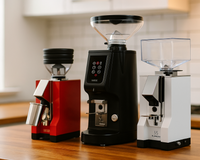The Impact of Water Quality on Coffee Brewing
When we discuss the art of coffee brewing, we often spotlight the beans, the roast, and even the method. Yet, there's an unsung hero in this symphony of flavors: water. Constituting over 98% of most brewed coffees, the quality of the water you use can profoundly influence the taste, aroma, and texture of your cup. But how does something so seemingly simple play such a pivotal role? From the intricacies of mineral composition to the subtle dance of pH levels, let's unravel the hidden tapestry of water in your daily brew.

Introduction
Water, often overshadowed by the allure of aromatic coffee beans, plays a role of paramount importance in the coffee-making process. It's not just the medium that extracts flavors, but an active participant in shaping the very essence of every cup. Accounting for over 98% of your brew, even minor nuances in water quality can be the difference between a forgettable sip and a memorable experience. Delving into the significance of water brings a deeper appreciation for every cup of coffee we cherish.
Related Article: What type of water should I use in my Lelit espresso machine?
The Basics of Water Composition
Coffee enthusiasts often delve deep into bean origins and roast profiles, but the intricacies of water composition remain largely uncharted territory. Yet, understanding what's in your water—beyond just H2O—can make a marked difference in your brew. Let's explore the fundamental components of water and their impact on extracting the perfect flavors from your beans.
The Importance of Water in Coffee
At a glance, coffee may seem defined by the rich colors, aromas, and flavors of the beans. However, in reality, when we brew coffee, we're primarily dealing with water. Whether you're enjoying a robust espresso or a light pour-over, the liquid is essentially water that has passed through the coffee grounds, extracting flavors, oils, and compounds along the way.
While the aromatic compounds and flavorful solubles from the coffee beans play a crucial role in defining the cup's character, they typically constitute only a small fraction—often less than 2%—of the final drink. The overwhelming majority, more than 98%, is water. This dominance underscores the importance of water quality and composition in shaping the taste, aroma, and mouthfeel of the coffee we love.
Video courtesy of La Marzocco USA.
Understanding TDS (Total Dissolved Solids)
TDS, or Total Dissolved Solids, refers to the total concentration of dissolved substances in water. This can include minerals, salts, metals, cations, and anions. Measured in parts per million (ppm), TDS provides an overview of water purity and mineral content. For coffee brewing, TDS is significant for several reasons:
-
Flavor Extraction: A certain level of dissolved minerals in water, especially calcium and magnesium, aids in the extraction of flavors from coffee grounds. Pure water, devoid of any minerals, can lead to flat or under-extracted coffee.
-
Balance & Mouthfeel: A moderate TDS can lend a balanced taste and desirable mouthfeel, preventing the coffee from tasting too thin or watery.
-
Preventing Over-extraction: Conversely, water with an extremely high TDS can over-extract flavors from coffee, leading to a bitter and unpleasant taste.
In essence, while TDS doesn't tell the whole story of water quality, it gives an essential snapshot. By understanding and controlling TDS levels, one can better optimize water for brewing and craft a consistently delicious cup of coffee.
How Minerals Affect Coffee Flavor
The dance of flavors in your coffee isn't led by coffee beans alone; the minerals in your water play a pivotal duet role. These silent influencers, often unnoticed, can elevate the notes of your brew or cast a shadow on its true potential.
Magnesium & Calcium: Friends to Flavor
Both magnesium and calcium act as catalysts in the coffee extraction process, but they interact with coffee compounds in distinct ways. Magnesium tends to attract and bind with larger flavor compounds, enhancing the perceived acidity and brightness in coffee. This means that waters richer in magnesium can lead to a brew that's vibrant and lively, often highlighting fruity and floral notes inherent in certain coffee beans.
On the other hand, calcium has a knack for extracting heavier compounds from coffee, lending more to the body and mouthfeel of the brew. A brew made with water high in calcium will often feel richer, with a fuller texture that lingers on the palate.
In ideal brewing water, a balance between magnesium and calcium can lead to a coffee that's both bright and full-bodied, harmoniously blending the best of both mineral interactions.
Chlorine and Coffee: A Love-Hate Relationship
Chlorine is commonly introduced into tap water as a disinfectant to kill harmful bacteria and other microbes. While it plays a crucial role in ensuring our water is safe to drink, when it comes to coffee brewing, chlorine can introduce a set of challenges:
-
Altered Flavor Profile: Chlorine can react with the aromatic compounds in coffee, leading to a brew that might taste off or slightly metallic. These reactions can mask the nuanced flavors and aromatics that high-quality coffee beans possess.
-
Flat Taste: Chlorine can diminish the vibrancy and liveliness of a coffee, rendering a cup that feels flat or stale, even if the beans used were freshly roasted.
-
Unpleasant Aftertaste: Some coffee drinkers report a lingering, chemical-like aftertaste in coffees brewed with chlorinated water, akin to the sensation of drinking straight from a swimming pool.
-
Inhibition of Extraction: Chlorine can potentially interfere with the proper extraction of flavors from the coffee grounds, leading to an inconsistent brew.
The Role of pH Levels in Coffee Brewing
Beyond minerals and impurities, the pH level of your water, a measure of its acidity or alkalinity, plays a nuanced role in the art of coffee brewing. A factor often overlooked, pH can be the silent conductor orchestrating the balance and taste of your brew. Let's dive into how this simple yet profound measure impacts the symphony of flavors in your cup.
Neutral vs. Alkaline vs. Acidic Water
The pH level of water, representing its acidity or alkalinity on a scale from 0 to 14, has a profound influence on coffee extraction. Here's how it comes into play:
-
Flavor Solubility: Coffee contains various flavor compounds, each with its own solubility characteristics. The pH of the water can favor the extraction of certain flavors over others. For instance, acidic water (below pH 7) can enhance the extraction of bright, acidic notes from the coffee, while alkaline water (above pH 7) might promote the extraction of bitter compounds.
-
Extraction Speed: The pH level can affect the rate at which flavors are extracted from coffee grounds. Alkaline water may slow down the extraction of acidic compounds, resulting in a cup that's less vibrant or lively. Conversely, water that's too acidic can lead to over-extraction of these compounds, making the coffee taste sour.
-
Bean Degradation: Extremely acidic or alkaline water can affect the integrity of the coffee bean during brewing, leading to an uneven extraction. This can result in brews that are inconsistent in flavor and mouthfeel.
-
Balance and Complexity: The right pH level, which many experts believe hovers around the neutral range, ensures a balanced extraction where no single flavor dominates. This promotes a coffee cup that is both complex and harmonious.
The Ideal pH for Brewing Coffee

The pursuit of the perfect cup of coffee involves fine-tuning various elements, and pH levels of the water used for brewing is one of those critical factors. So, what is the ideal pH for brewing coffee?
-
Neutral to Slightly Acidic Range: Most coffee experts and specialty coffee associations recommend water with a pH level that is near neutral, but slightly on the acidic side. A pH level of around 6.5 to 7.5 is considered optimal. This range ensures a balanced extraction, allowing the coffee's intrinsic flavors and aromas to shine without being overshadowed by extreme acidity or bitterness.
-
Importance of Consistency: While the aforementioned range is considered ideal, consistency is key. Using water with a consistent pH level, even if it's slightly outside of the 6.5-7.5 range, can still produce delicious coffee. What's vital is understanding how that pH interacts with your particular beans and adjusting your brewing parameters accordingly.
-
Source and Treatment: It's essential to remember that the source of your water (tap, spring, mineral) and any treatment it has undergone (filtering, softening, or remineralization) can influence its pH. Regularly testing the water's pH, especially if you notice inconsistencies in your brew, can be beneficial.
-
Interplay with Minerals: The pH is just one facet of water quality. It works in conjunction with other factors, like the presence of calcium and magnesium, to influence the final taste. For instance, even if the pH is optimal, high levels of certain minerals might skew the flavor profile.
Filtering Water for the Perfect Brew
In the quest for the perfect cup of coffee, every detail counts, right down to the purity and composition of the water you use. Filtering your water, often a step overlooked in the brewing process, can be the transformative element that elevates your coffee from good to exceptional. Let's delve into the world of water filtration and unveil its impact on crafting the impeccable brew.

Why Filter Your Water?
Water, though seemingly clear and pure, can contain a myriad of invisible contaminants and elements that can influence the taste and quality of your brewed coffee. Filtering becomes essential not just for health reasons but also to guarantee a consistent and flavorful brew. Here's a breakdown of common contaminants and off-flavors that filtration can help tackle:
-
Chlorine and Chloramines: As previously mentioned, many municipal water supplies use chlorine or chloramines as disinfectants. While effective at eliminating harmful bacteria, they can impart a noticeable chemical taste to water, subsequently marring the flavor of your coffee. A good activated carbon filter can effectively remove these compounds.
-
Hard Minerals: Excessive amounts of calcium and magnesium can cause scale build-up in your coffee equipment, reducing its lifespan and efficiency. While these minerals play a role in flavor extraction, too much can result in over-extraction. Softening filters can help balance the mineral content.
-
Metals: Traces of metals like iron, copper, and lead might be present in some water sources. These metals not only pose health risks but can also introduce off-flavors into your brew. Certain specialized filters are designed to remove or reduce metallic contaminants.
-
Organic Compounds: Organic matter, from decaying vegetation or agricultural runoff, can sometimes find its way into water supplies. These compounds can lead to earthy, musty, or moldy off-notes in your coffee. Activated carbon filters are especially effective at tackling these.
-
Sediments: Fine particles and sediments can come from various sources, including corroded pipelines or natural minerals. Though they might not always directly impact flavor, they can affect the consistency and clarity of your brew. Mechanical filters with fine mesh or membranes can remove these particles.
-
Other Chemical Contaminants: Pesticides, herbicides, and industrial contaminants might be present in trace amounts in some water sources. These can introduce both health risks and unexpected flavors. Multi-stage filters that combine activated carbon with other filtering mechanisms can help in reducing these impurities.
In essence, filtering water for coffee brewing isn't just about achieving a neutral taste—it's about creating a blank canvas on which the coffee can paint its rich tapestry of flavors. By removing unwanted contaminants and flavors, you allow the coffee to present its best and truest self in every cup.
Popular Filtration Systems for Coffee Enthusiasts
For an avid coffee enthusiast or a professional barista, the choice of water filtration can significantly impact the taste and quality of the brew. Let's dive into some of the most popular filtration systems suited for coffee brewing, comparing their functions and benefits.
1. Activated Carbon Filters
- Function: Made from carbon-rich materials like coconut shells or wood, these filters absorb impurities as water passes through.
- What it Removes: Chlorine, chloramines, organic compounds, certain pesticides, and some sediments. It can also improve taste and odor.
- Advantages: Relatively inexpensive, easy to install, and widely available.
- Limitations: Doesn't effectively remove certain heavy metals, dissolved solids, or hard water minerals. Requires regular replacement to prevent bacterial growth.
Shop Active Carbon Filtration Systems on Amazon >
2. Reverse Osmosis (RO) Systems (**NOT RECOMMENDED)
- Function: Uses a semi-permeable membrane to filter out contaminants. Water is forced through this membrane, leaving impurities behind.
- What it Removes: Most contaminants, including heavy metals, sediments, dissolved solids, and even some bacteria and viruses.
- Advantages: Highly effective in producing pure water. Can be combined with activated carbon pre-filters or post-filters for comprehensive filtration.
- Limitations: Can remove beneficial minerals, leading to flat-tasting coffee. It also wastes some water in the process. Requires more maintenance than simple filters.
Shop RO Water Systems on Amazon >
3. Water Softeners
- Function: Primarily designed to deal with hard water by exchanging calcium and magnesium ions with sodium ions.
- What it Removes: Hard water minerals (calcium and magnesium).
- Advantages: Prevents scale build-up in coffee machines, which can extend the equipment's lifespan. Improves the overall taste for regions with very hard water.
- Limitations: Doesn't remove other contaminants like chlorine or organic compounds. The added sodium might not be suitable for all diets.
Shop Water Softening Systems on Amazon >
4. Ceramic Filters
- Function: Made from porous ceramic material, water passes through, leaving larger contaminants behind.
- What it Removes: Sediments, some bacteria, and cysts.
- Advantages: Environmentally friendly and doesn't require electricity. The filter can often be cleaned and reused.
- Limitations: Doesn't remove dissolved solids, chemicals, or chlorine.
5. Ion Exchange Filters
- Function: Similar to water softeners, these filters trap undesirable ions and release more desirable ones.
- What it Removes: Hardness minerals, some heavy metals.
- Advantages: Softens water and can improve taste.
- Limitations: Limited scope in terms of contaminants filtered.
Testing and Adjusting Your Water at Home
Crafting the perfect cup of coffee at home isn't just about selecting the finest beans or mastering your brewing technique; it's also about understanding and optimizing the water you use. Water quality can vary widely, even from one neighborhood to the next, making testing and adjustments essential for consistently great results. If you're keen on diving deep into the art of home brewing, exploring the waters (quite literally) is a step you shouldn't skip.
Here's a guide to testing and fine-tuning your water, ensuring your brew always hits the right notes.
Home Water Testing Kits
Ensuring your water is of the highest quality for brewing can make a significant difference in your coffee's taste. Fortunately, several home water kits on the market can help you understand your water's composition.
Shop Home Water Testing Kits >
Recommended Home Water Kits:
-
API Master Test Kits: Widely available and originally designed for aquariums, they provide tests for different parameters, including pH, hardness, and certain contaminants.
-
LaMotte BrewLab Test Kit: Designed specifically for brewers, this kit provides a comprehensive analysis of the most important water parameters for brewing coffee and beer.
-
TDS (Total Dissolved Solids) Meters: These are handheld electronic devices that quickly measure the total concentration of dissolved solids in your water. They can't specify which minerals are present but can give a general idea of water purity.
-
Hach Softness Test Strips: Simple-to-use strips that measure water hardness by detecting levels of calcium and magnesium.
Brief Guide on Using Home Kits:
-
Collect a Sample: Draw a water sample from the tap you use for brewing. Ensure the water has run for a few seconds to get a consistent sample.
-
Follow Instructions Carefully: Each kit will have its specific instructions. Some might require you to dip a test strip into the water sample, while others might involve adding a drop of a reagent. Ensure you follow the provided guidelines for accurate results.
-
Document Results: Note down your findings, especially if you're testing multiple parameters or using different kits. This can help you track changes over time or after implementing filtration or adjustment solutions.
-
Interpretation: Use the results to determine if your water is too hard, too soft, or if there are unwanted contaminants. Kits often come with a guide or chart that can help you interpret the results relative to ideal brewing conditions.
-
Make Adjustments: Based on your findings, you might decide to invest in a filtration system, a water softener, or even remineralization solutions. For instance, if your water is too pure (like with some RO systems), you might want to add minerals back in to reach the desired TDS for brewing.
-
Re-Test Periodically: Water quality can change over time due to various factors such as seasonal changes, municipal water treatment adjustments, or aging infrastructure. It's a good idea to test your water every few months or if you notice any changes in your coffee's taste.
Remember, the goal of testing and adjusting your water is not just to hit specific scientific benchmarks but to optimize your water for the best-tasting coffee. Personal preferences play a big role, so use the test results as a guide and trust your palate in the end.















